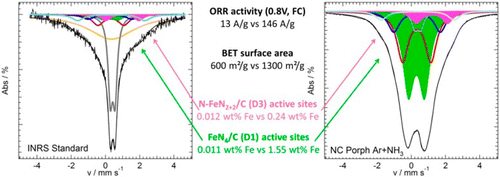Correlations between Mass Activity and Physicochemical Properties of Fe/N/C Catalysts for the ORR in

The aim of this work is to clarify the origin of the enhanced PEM-FC performance of catalysts prepared by the procedures described in Science 2009, 324, 71 and Nat. Commun. 2011, 2, 416. Catalysts were characterized after a first heat treatment in argon at 1050 °C (Ar) and a second heat treatment in ammonia at 950 °C (Ar + NH3). For the NC catalysts a variation of the nitrogen precursor was also implemented. 57Fe Mössbauer spectroscopy, X-ray photoelectron spectroscopy, neutron activation analysis, and N2 sorption measurements were used to characterize all catalysts. The results were correlated to the mass activity of these catalysts measured at 0.8 V in H2/O2 PEM-FC. It was found that all catalysts contain the same FeN4-like species already found in INRS Standard (Phys. Chem. Chem. Phys. 2012, 14, 11673). Among all FeN4-like species, only D1 sites, assigned to FeN4/C, and D3, assigned to N-FeN2+2 /C sites, were active for the oxygen reduction reaction (ORR). The difference between INRS Standard and the new catalysts is simply that there are many more D1 and D3 sites available in the new catalysts. All (Ar + NH3)-type catalysts have a much larger porosity than Ar-type catalysts, while the maximum number of their active sites is only slightly larger after a second heat treatment in NH3. The large difference in activity between the Ar-type catalysts and the Ar + NH3 ones stems from the availability of the sites to perform ORR, as many sites of the Ar-type catalysts are secluded in the material, while they are available at the surface of the Ar + NH3-type catalysts.